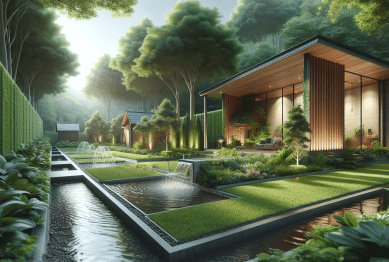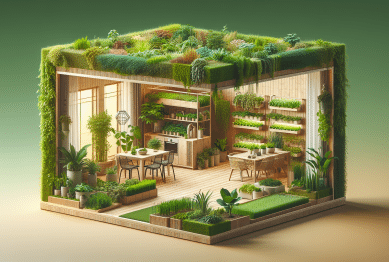Unlock the secrets behind building a drought-resilient garden that thrives with less water. This guide explores landscape strategies, plant selection, watering methods, and soil optimization for sustainable home gardening and water savings.
Why Drought-Resilient Gardening Matters
Drought-resilient gardening continues to gain popularity as climate patterns shift and dry spells become more frequent. Creating a landscape that requires minimal irrigation protects resources and increases the sustainability of your outdoor space. Homeowners are finding that drought-tolerant yards not only use less water but can also thrive where traditional gardens struggle. These gardens support local ecosystems and save time on maintenance while lowering overall water use.
Many communities encourage residents to transition to water-saving gardening approaches. Regional water restrictions, rising utility costs, and environmental awareness drive homeowners to rethink common landscaping strategies. Drought-resilient gardens rely on native plants, smart irrigation, and careful soil prep to flourish with less dependence on rainfall. This approach preserves groundwater, benefits pollinators, and enhances neighborhood curb appeal without the constant need for supplemental watering.
The positive impact of water-efficient landscaping extends beyond the individual yard. Municipalities benefit from reduced strain on public water systems. A thoughtfully curated landscape contributes to urban cooling and erosion control during dry and wet cycles. Adopting drought-smart practices has become a practical, environmentally responsible choice for modern homeowners seeking reliable, beautiful outdoor spaces.
Selecting Drought-Tolerant Plants for Your Landscape
Plant selection is central to building a landscape resilient to drought. Native species are adapted to local rainfall patterns, making them outstanding candidates for low-water yards. Succulents like agaves, sedums, and certain euphorbias store moisture in their leaves, allowing them to handle long dry periods. Ornamental grasses, lavender, and yarrow are also known for their ability to withstand drought conditions and provide multi-season interest.
Grouping plants with similar water needs helps maximize efficiency and ensures your garden thrives. The concept of hydrozoning involves clustering high, medium, and low water-use plants within distinct zones of the garden. This method streamlines irrigation and reduces waste. Take care to avoid thirsty exotics—these can demand more resources, diminishing the environmental benefits of your drought-resilient design.
Research from horticultural experts highlights the value of soil health in plant survival. Healthy soil rich in organic matter retains moisture longer and reduces the need for watering. Incorporating mulch and compost nourishes the ground and insulates plant roots, further enhancing the drought tolerance of garden plantings. Choose varieties bred for heat and dryness, and support them with soil that stays cool and moist under the surface.
Design Strategies for Minimum Water Use
Smart landscape design goes beyond just plant selection. Layout changes and structural elements play a significant role in reducing water demand. Consider replacing grass lawns with groundcovers, stone paths, or gravel areas—these features require little to no irrigation and add texture to the garden. Contouring the land into gentle slopes or shallow basins channels rainwater directly to plant roots, making every drop count.
Rainwater harvesting is another practical approach. By directing gutter downspouts or roof runoff to garden beds or storage barrels, homeowners can store and use rainwater during dry periods. Efficient drip irrigation systems, when thoughtfully installed, further reduce waste by delivering water only where it’s needed. Timing irrigation for early morning minimizes evaporation and maximizes absorption.
Hardscape materials also impact the garden’s ability to retain moisture. Permeable paving stones and wood chips prevent runoff, encourage infiltration, and cool the soil. Decorative rocks and gravel not only create design interest but also act as mulch to cut evaporation. Together, these strategies produce an appealing, water-wise landscape that requires less ongoing intervention and remains attractive throughout tough seasons.
Soil Preparation and Mulching Secrets
The first step in soil preparation is to evaluate texture and drainage. Sandy soils lose water quickly, while heavy clay holds it longer but can become compacted. Amending soil with compost or coconut coir improves its structure and increases its moisture-holding ability. Testing pH and nutrient levels helps identify adjustments required to support vigorous, drought-tolerant planting.
Mulching is a tried-and-tested technique for water retention. Organic mulches like bark, straw, or shredded leaves insulate the ground, reduce evaporation, and slowly decompose, feeding the soil. A two- to four-inch layer around plantings discourages weed growth and provides a buffer against summer heat swings. Choosing natural, locally sourced mulch materials also reduces the garden’s environmental footprint.
Soil health translates directly to water savings in the garden. Encouraging beneficial soil microbes through organic amendments results in plants with stronger roots and increased drought tolerance. Over time, well-mulched and nourished soil becomes more absorbent and resilient, supporting lush growth even in reduced-rainfall conditions. Healthy earth is the foundation of every successful water-wise landscape.
Watering Wisely for Sustained Growth
Efficient watering is key to a thriving, low-water landscape. Deep, infrequent watering helps plants develop long roots, making them more resilient during hot spells. Observing soil moisture before irrigating ensures resources are not wasted. Tools like moisture meters or simple finger tests can guide timing and quantity for optimal results.
Modern irrigation technology supports smart water management. Drip systems direct moisture exactly to root zones, while soaker hoses maintain slow, even watering to minimize runoff. Rain sensors and programmable timers take the guesswork out of scheduling, automatically adjusting for weather changes. Incorporating these systems drastically reduces water consumption and plant stress.
Monitoring plant health allows adjustments as seasons progress. Wilting, scorched leaves, or stunted growth may indicate insufficient water or root competition. Mulch use, proper spacing, and selective pruning encourage airflow and healthy growth. Over time, plants adapt to survive and even flourish with minimal supplemental watering, proving the value of drought-adapted practices for lasting home garden success.
Maximizing Garden Beauty in Tough Climates
Drought-resistant landscaping absolutely does not mean sacrificing curb appeal. Creative use of foliage color, texture, and structure can turn a water-wise yard into a striking feature of any property. Agaves, yuccas, ornamental sages, and lavender offer dramatic silhouettes and visual interest year-round, without demanding constant attention.
Attracting pollinators is another reward. Many drought-adapted species also serve as food sources for bees, butterflies, and hummingbirds. Thoughtful combinations ensure a lively garden that sustains both people and local wildlife throughout the hottest, driest months. Grouping flowering plants provides a longer season of color while keeping irrigation needs consolidated.
Incorporating native stones, decorative pots, and garden art adds distinct character and charm to the landscape. These features require no watering and forge a connection between the built and natural environments. By blending drought resilience with creative flair, homeowners craft gardens that are truly enjoyable, practical, and beautiful all year round.
References
1. United States Environmental Protection Agency. (n.d.). Water-Efficient Landscaping. Retrieved from https://www.epa.gov/watersense/water-efficient-landscaping
2. The National Gardening Association. (n.d.). Drought-Tolerant Gardening. Retrieved from https://garden.org/learn/articles/view/531/
3. University of California Agriculture and Natural Resources. (n.d.). Lawn Watering Guide. Retrieved from https://ucanr.edu/sites/WUCOLS/
4. Colorado State University Extension. (n.d.). Xeriscaping: Creative Landscaping. Retrieved from https://extension.colostate.edu/topic-areas/yard-garden/xeriscaping-7-228/
5. Royal Horticultural Society. (n.d.). Gardening with Less Water. Retrieved from https://www.rhs.org.uk/advice/profile?pid=396
6. U.S. Department of Agriculture. (n.d.). Drought Resistant Plants. Retrieved from https://www.fs.usda.gov/wildflowers/ethnobotany/drought.html









